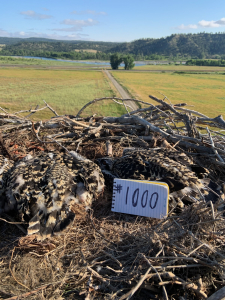YVAS OSPREY NEST MONITORING PROJECT
One of YVAS’ ongoing conservation projects has been the Yellowstone River Osprey Nest Monitoring Project which began in 2009. By 2012, the Project had grown from a 120-mile stretch between Big Timber and Pompey’s Pillar to roughly a 320-mile stretch between Gardiner and Miles City.
Monitoring Nests
On average, there are 40 to 45 dedicated volunteer nest monitors that record dates and observations at their “adopted” nests beginning in late March and early April. Among the recorded information is Ospreys’ arrival at the nest, nest building, incubation, brooding, fledging, and noteworthy events. For more information on the YVAS Osprey Nest Monitoring Project, contact Deb Regele at debregele@gmail.com.
Banding Nestlings
In 2012, banding of Osprey nestlings became a very significant part of the Project. Dr. Marco Restani began banding nestlings as well as providing an annual spring Osprey Orientation programs to the nest monitors.
In 2025, the 1,000th nestling was banded with the Yellowtone River’s assigned green band. On average, 11% of each year’s fledglings will survive to breed with most nesting along the Yellowstone River or other Montana rivers. Numerous sightings of these Yellowstone River Ospreys have been received from observers along the Gulf Coast and in Central America.
All nest monitoring data is submitted annually to the Montana Natural Heritage Program where it is recorded and made available to all individuals, organizations or groups. The banding records are submitted to the Bird Banding Lab, a division of the Patuxent Wildlife Research Center in Maryland.
Establishing Safe Nesting Sites for Ospreys
Ospreys have a dangerous habit of building nests on top of active power poles. These nests not only endanger the Ospreys and their young, they create problems for utility companies, cause power outages and create fire hazards. YVAS began working with utility companies and landowners in 2010 to establish free standing osprey nesting poles/platforms along the Yellowstone River and its tributaries. In most cases, the utility companies (Yellowstone Valley Electric, Northwestern Energy, Montana Dakota Utilities, Beartooth Electric and Park Electric) have donated their material, equipment and manpower to help alleviate these situations by installing nesting poles/platforms at problematic sites. YVAS helps to fund the poles and platforms when needed.
Ospreys are very fond of baling twine and will incorporate it into their nests where the nestlings and adults can become entangled. Without human intervention, the entangled birds most certainly would die. Loose uncontained twine can cause injury, suffering and sometimes death by entanglement for other birds, wildlife and livestock. Canada Geese and livestock are known to ingest twine and sometimes die.
Deer, elk and antelope are seen every year with masses of twine or net wrap on their antlers and horns making it difficult for them to see, eat or defend against predators. In 2018, two bull elk had their antlers entangled together and had to be euthanized by MT Fish, Wildlife and Parks officers near Columbus MT.
Twine dangling from Osprey nests on utility poles can cause costly power outages and can lead to wildfires. It is also a nuisance for highway mowing and field equipment and can cause costly breakdowns.
Twine as well as mesh wrap needs to be contained and out of the reach of all wildlife.
Osprey Photos
Osprey Nest Monitoring and Banding
Osprey News and Published Articles
Journal of Raptor Research 2023 by Dr. Marco Restani
Ecology and Conservation of Ospreys Along the Yellowstone River, Montana – 2021 Annual Report
Prepared by Dr. Marco Restani
Climbing in the Bird-Tower Environment: First Principle
Tower Times May/June 2019 by Dr. Marco Restani
The Osprey Project
Big Sky Journal Fall 2019 by Melynda Harrison
Golden Eagle Preys upon Fledgling Osprey in Montana
The Raptor Research Foundation 2015 by Dr. Marco Restani
North American Bird Observatory
Spring/Summer 2015
North American Bird Bander
July – September 2014
Additional Information and History
Between the early 1950’s and early 1970’s, the use of the pesticide DDT was widespread in many countries including the United States. By the late 1960’s, the population numbers of brown pelicans, bald eagles, peregrine falcons, white pelicans, golden eagles, ospreys, and other birds had declined significantly. This decline in population numbers was due to such things as birds’ failure to reproduce due to the affect DDT has on a bird’s ability to metabolize calcium resulting in the thinning and breaking of eggshells. In 1972, when the Environmental Protection Agency was established, the EPA banned the use of DDT in most regions of the United States.
Birds in Montana, including the osprey, were no exception to the devastating effects of DDT. Osprey numbers as well as numbers of other bird species have been steadily increasing since DDT was banned in 1972. Ospreys’ summer range has been moving eastward from western Montana especially along the Yellowstone and Missouri Rivers. Today, ospreys are frequently seen along the Yellowstone River between April and as late as early November.



